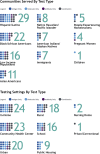RADx-UP Testing Core: Access to COVID-19 Diagnostics in Community-Engaged Research with Underserved Populations
- PMID: 37395655
- PMCID: PMC10446854
- DOI: 10.1128/jcm.00367-23
RADx-UP Testing Core: Access to COVID-19 Diagnostics in Community-Engaged Research with Underserved Populations
Abstract
Research on the COVID-19 pandemic revealed a disproportionate burden of COVID-19 infection and death among underserved populations and exposed low rates of SARS-CoV-2 testing in these communities. A landmark National Institutes of Health (NIH) funding initiative, the Rapid Acceleration of Diagnostics-Underserved Populations (RADx-UP) program, was developed to address the research gap in understanding the adoption of COVID-19 testing in underserved populations. This program is the single largest investment in health disparities and community-engaged research in the history of the NIH. The RADx-UP Testing Core (TC) provides community-based investigators with essential scientific expertise and guidance on COVID-19 diagnostics. This commentary describes the first 2 years of the TC's experience, highlighting the challenges faced and insights gained to safely and effectively deploy large-scale diagnostics for community-initiated research in underserved populations during a pandemic. The success of RADx-UP shows that community-based research to increase access and uptake of testing among underserved populations can be accomplished during a pandemic with tools, resources, and multidisciplinary expertise provided by a centralized testing-specific coordinating center. We developed adaptive tools to support individual testing strategies and frameworks for these diverse studies and ensured continuous monitoring of testing strategies and use of study data. In a rapidly evolving setting of tremendous uncertainty, the TC provided essential and real-time technical expertise to support safe, effective, and adaptive testing. The lessons learned go beyond this pandemic and can serve as a framework for rapid deployment of testing in response to future crises, especially when populations are affected inequitably.
Keywords: COVID-19; RADx-UP; diagnostics; equity; underserved communities.
Conflict of interest statement
The authors declare a conflict of interest. Ephraim Tsalik has been a consultant for Biomeme, Inc.; has a patent pending for Methods to Diagnose and Treat Acute Respiratory Infections (US20180245154A1); and is currently employed by Danaher Corp. Michael Cohen-Wolkowiez receives support for research from the NIH [1U24-MD016258]; National Institute of Allergy and Infectious Diseases [HHSN272201500006I, 1K24-AI143971]; U.S. Food and Drug Administration [5U18-FD006298]; and industry for drug development in adults and children. Cathy A Petti receives consulting fees from Abbott Molecular and Rapid Diagnostics. Christopher Woods reports consulting fees from Arena Pharmaceuticals, BioFire, FHI Clinical, Giner, Karius, and SeLux Diagnostics. All other authors report no conflicts of interests.
Figures


Similar articles
-
Standardizing, harmonizing, and protecting data collection to broaden the impact of COVID-19 research: the rapid acceleration of diagnostics-underserved populations (RADx-UP) initiative.J Am Med Inform Assoc. 2022 Aug 16;29(9):1480-1488. doi: 10.1093/jamia/ocac097. J Am Med Inform Assoc. 2022. PMID: 35678579 Free PMC article. Review.
-
Qualitative Evaluation of RADx-UP Projects Addressing COVID-19 Testing Disparities Among Underserved Populations.Am J Public Health. 2024 May;114(S5):S410-S415. doi: 10.2105/AJPH.2024.307632. Epub 2024 Mar 28. Am J Public Health. 2024. PMID: 38547469 Free PMC article.
-
Exploring barriers and facilitators of implementing an at-home SARS-CoV-2 antigen self-testing intervention: The Rapid Acceleration of Diagnostics-Underserved Populations (RADx-UP) initiatives.PLoS One. 2023 Nov 16;18(11):e0294458. doi: 10.1371/journal.pone.0294458. eCollection 2023. PLoS One. 2023. PMID: 37971996 Free PMC article.
-
A Systems Perspective of How Community-Engaged Public Health Addresses Social Determinants of Health: A Case Study of a Population-Based COVID-19 Testing Program.J Public Health Manag Pract. 2025 May-Jun 01;31(3):E169-E178. doi: 10.1097/PHH.0000000000002089. Epub 2025 Feb 3. J Public Health Manag Pract. 2025. PMID: 39908414
-
The critical role of engineering in the rapid development of COVID-19 diagnostics: Lessons from the RADx Tech Test Verification Core.Sci Adv. 2023 Apr 7;9(14):eade4962. doi: 10.1126/sciadv.ade4962. Epub 2023 Apr 7. Sci Adv. 2023. PMID: 37027461 Free PMC article. Review.
Cited by
-
Innovation landscape in nanobiosensors for COVID-19 detection and future implications for a resilient Global Health Security.3 Biotech. 2025 Jun;15(6):170. doi: 10.1007/s13205-025-04342-1. Epub 2025 May 15. 3 Biotech. 2025. PMID: 40386630 Review.
-
Feasibility of pharmacy-based research opportunity to enhance community testing and surveillance.J Am Pharm Assoc (2003). 2025 Jan-Feb;65(1):102151. doi: 10.1016/j.japh.2024.102151. Epub 2024 Jun 29. J Am Pharm Assoc (2003). 2025. PMID: 38950882
References
Publication types
MeSH terms
Grants and funding
LinkOut - more resources
Full Text Sources
Medical
Miscellaneous

